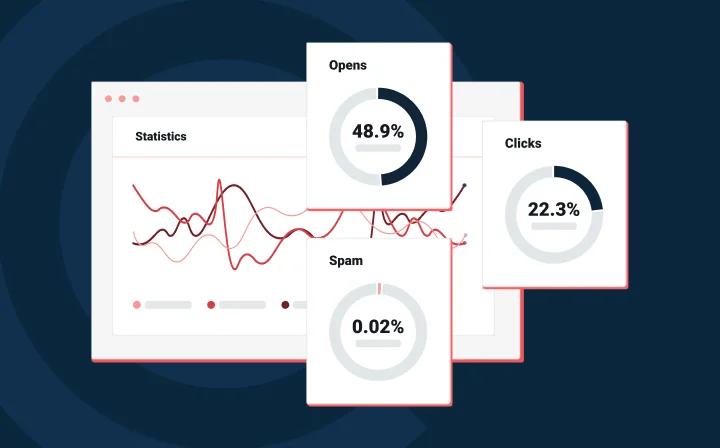Deliverability
Make things easy with email list management best practices

Deliverability

As an email service provider (ESP) we know how layered the email world can be. To be a successful sender, you must master everything from email deliverability, to ROI, email marketing metrics, send-time optimization, analytics, and open conversion and click-through rates.
We hate to say it, but sending email isn’t just about coding a perfect responsive HTML email template and blasting it out to your subscriber list. Even at that point, you have to ask yourself: Should I send via an email API or SMTP?
In this post we’re focusing specifically on email list management. This must-do best practice saves time and resources while boosting your email marketing strategies. We’ll explain what email list management is and some best practices. Plus, we’ll leave you with the best pro tips to streamline your marketing automations and workflow with Mailgun’s email list management service.
Email list management is your strategy for managing your email contact list.
From a technical perspective, it’s how you:
From a marketing perspective, it gives you a validated contact database to:
Okay, at this point, you’re probably thinking, “Wait, isn’t it enough if I’ve carefully built an email list the right way?”
First, let’s make sure we’re on the same page about what the right way is. Getting new subscribers is more than half the battle, but you want to grow your list organically – not purchase existing lists or find covert ways to capture emails… but more on this later.
But even a well-built email list won’t deliver results if it’s not maintained properly.
You might have great content and beautifully designed templates, but if your list is cluttered with outdated or inactive contacts, your efforts could be in vain. As your small business evolves, so should your email list. Regular cleaning and management help keep your campaigns effective, your bounce rate low, and your emails out of junk folders.
Beyond the obvious, here’s why email list management matters:
These issues directly impact your sender reputation and, ultimately, your deliverability. We’ll help you avoid landing in spam traps, winding up on blocklists, and being flagged by ISPs with email list management best practices.
So how do you get ahead of email deliverability issues? Follow these best practices for list management:
Keep your email list clean by ensuring the addresses on your list are valid email addresses. Email validation helps ensure that the addresses on your mailing list are valid and error-free, so they won’t bounce.
To make sure you have the right email addresses, you can add email validation to your sign-up forms. Want to try it for yourself? Check out our email verifications tool.
Watch out for soft and hard bounces. You’ll need to update your mailing list if you’re sending messages and they bounce back.
With ISP feedback and automatic suppressions, you can continually monitor and make updates to your email list to improve open rates for your email campaigns and protect your reputation. Keep your delivery rates high by removing email addresses that bounce back messages before you send out your next email marketing campaign.
Reduce the number of invalid addresses on your mailing list using sign-up forms with double opt-in measures. This is a great way to ensure addresses are correct and your readers want to receive your emails.
Make it easy for your readers to unsubscribe. It’s always sad to see them go but trust us; you’d much rather say goodbye than have them mark your emails as spam. Clear unsubscribe links make list management a self-serve function. Disinterested users will become unengaged subscribers, and that dilutes your target audience by impacting your deliverability.
Not all users will be lifelong users. Developing a sunset policy gives you a playbook to plan re-engagement strategies around low engagement users, and creates a process for retiring inactive users that are hurting your engagement metrics.
Effective email list management starts with building a solid list of engaged contacts who actually want to hear from you. Buying or renting email addresses isn’t just a poor investment – it can hurt your deliverability and reputation. Instead, focus on permission-based lists where users opt in to receive your emails. The best email marketing tools support this approach and help you manage your list with compliance and precision.
To improve email delivery rates, businesses often turn to third-party email marketing platforms that offer free or freemium plans, with real-time analytics and strong deliverability.
Mailgun’s platform offers powerful tools for email list management that scale with your business. As your audience grows, you can send unlimited emails at a competitive price – all while benefiting from top-tier customer service at every level. Try Mailgun for free and see for yourself.
List management is a mission-critical email marketing tool. Regardless of the platform you use to send, be it Mailgun, Mailchimp, Hubspot, or some other email marketing software, list hygiene helps to ensure a higher open rate with a lower bounce rate, and way less chance of landing in the spam folder. Whether you decide to manage your mailing list yourself or use email list management tools and strategies, remember that a clean email list is vital to a healthy ecommerce email campaign.
Ready to get cracking? Try Mailgun’s email validation tools and check out our other email tools to improve your email campaigns and boost your reader engagement. And don’t worry, if you have questions, we’ve got you covered for all your digital marketing efforts from your welcome email to your transactional email program.
Send me the Mailjet Newsletter. I expressly agree to receive the newsletter and know that I can easily unsubscribe at any time.